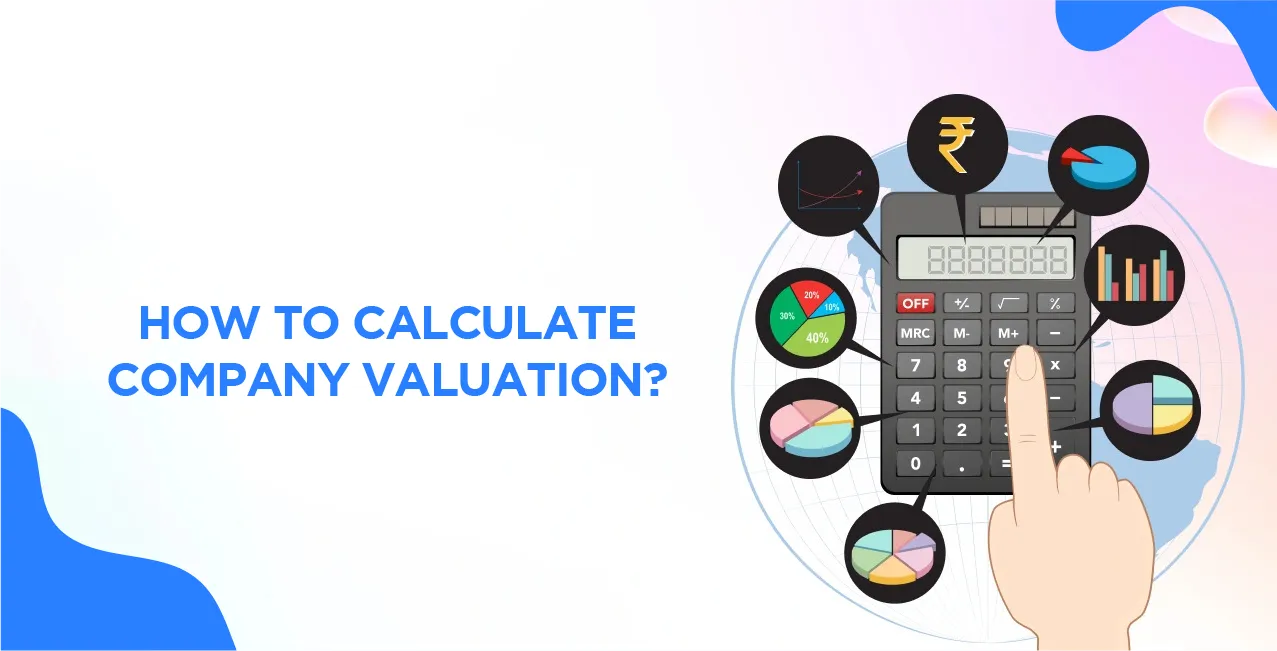
Author
LoansJagat Team
Read Time
8 Min
10 Jun 2025
How to Calculate Company Valuation – Step-by-Step Guide
Before Diwaker pays for a business, he looks at the company's valuation to assess its worth. You can find out easily by performing this calculation.
Revenue Multiple Method: Multiply the company’s annual revenue by an industry average (e.g., 3x for tech startups).
- Example: If a company earns ₹10 lakh/year, valuation = ₹10 lakh x 3 = ₹30 lakh.
Profit Multiple Method: Multiply the annual profit (P/E ratio).
- Example: Profit = ₹5 lakh, P/E = 6 to Valuation = ₹5 lakh x 6 = ₹30 lakh.
Asset-Based Method: Add the value of all assets (e.g., ₹20 lakh) minus debts (e.g., ₹5 lakh) = ₹15 lakh.
Example Table
Method | Calculation | Valuation |
Revenue Multiple | ₹10,00,000 x 3 | ₹30,00,000 |
Profit Multiple | ₹5,00,000 x 6 | ₹30,00,000 |
Asset-Based | ₹20,00,000 - ₹500,000 | ₹15,00,000 |
Diwaker relies on these techniques to help him find the finest investment options. When a company’s value isn’t high, you have an opportunity to make a lot of money from it later.
Market Capitalisation (For Public Companies)
Market capitalisation (or "market cap") is the easiest way to value a publicly traded company. It tells you how much the entire company is worth based on its current stock price.
How it works:
- Multiply the company’s current share price by the total number of shares it has.
- The result is the company’s total market value.
Example:
Diwaker wants to invest in a company called ABC Ltd.
- Current share price = ₹500
- Total shares = 2 million
Read More – How To Calculate Gross Profit in 2025
Calculation:
Market Cap = Share Price × Total Shares
= ₹500 × 2,000,000
= ₹1,000,000,000 (₹1000 crore)
This means ABC Ltd. is worth ₹1000 crore in the stock market.
Why Diwaker Uses Market Cap?
- Quick comparison: Helps compare companies of different sizes.
- Easy to calculate: Just two numbers are needed (price and shares).
- Real-time value: Changes with stock price movements.
Market Cap Table:
Company | Share Price | Total Shares | Market Cap |
ABC Ltd. | ₹500 | 2 million | ₹1000 crore |
XYZ Corp. | ₹200 | 5 million | ₹1000 crore |
Key Takeaway:
If one business has a much higher share price than another but a similar market cap, they may sell the same number of shares. Diwaker applies this to help discover what stocks are fairly valued.
Revenue Multiple Method (For Startups & Growing Businesses)
With this approach, companies are valued for their revenue, not their profits. Enterprises transitioning into growth but struggling to turn a profit find this especially helpful.
How it works:
- Find the company's annual revenue (total sales).
- Multiply by an industry multiple (2x, 5x, 10x, etc.).
- The result gives the estimated company value.
Example:
Diwaker is looking at a SaaS startup:
- Annual revenue = ₹80 lakh
- Industry multiple = 6x (common for tech startups)
Calculation:
Valuation = Revenue × Multiple
= ₹80 lakh × 6
= ₹4.8 crore
Diwaker might invest if he believes the company can grow.
Why Diwaker Likes This Method
- Simple for early-stage companies.
- Focuses on growth potential.
- Commonly used by investors.
Revenue Multiples by Industry
Industry | Typical Multiple | Example (₹50L revenue) |
Tech Startup | 5x - 10x | ₹2.5L - ₹5L crore |
Retail Store | 0.5x - 2x | ₹25L - ₹1L crore |
Restaurant | 1x - 3x | ₹50L - ₹1.5L crore |
Remember: When firms have a high multiple, investors think the company will grow more quickly. He analyses competing companies to make the right decision.
Earnings Multiple (P/E Ratio) – For Profitable Businesses
With this method, company growth is valued through profits. It helps companies that already make reliable profits.
How it works:
- Find the company's annual net profit (after all expenses).
- Multiply by the industry P/E ratio (price-to-earnings multiple).
- The result gives the company's estimated value.
Example:
Diwaker is analysing a manufacturing company:
- Annual profit = ₹1.2 crore
- Industry P/E ratio = 8x (common for stable businesses)
Calculation:
Valuation = Net Profit × P/E Ratio
= ₹1.2 crore × 8
= ₹9.6 crore
Why Diwaker Uses This Method?
- Focuses on actual profitability.
- Good for comparing similar companies.
- Works best for stable, cash-flow-positive businesses.
Typical P/E Ratios by Industry:
Industry | Typical P/E | Example (₹1cr profit) |
Manufacturing | 8x - 12x | ₹8cr - ₹12cr |
IT Services | 15x - 25x | ₹15cr - ₹25cr |
FMCG (Consumer Goods) | 20x - 30x | ₹20cr - ₹30cr |
Key Point: A Higher P/E means investors expect faster profit growth. Diwaker looks for reasonable P/Es compared to industry averages.
Also Read - Financial Metrics Every Business Owner Should Track
Discounted Cash Flow (DCF) – For Long-Term Investments
Using DCF, Diwaker can determine a company’s true worth by looking at the future cash flows it will generate.
How it works:
- Estimate the company’s future yearly cash flows.
- Apply a discount rate (accounts for risk and time).
- Add up all discounted cash flows.
Example:
Diwaker evaluates a logistics company:
- Year 1 cash flow: ₹50 lakh
- Year 2 cash flow: ₹60 lakh
- Discount rate: 12% (reflecting risk)
Calculation:
Year 1: ₹50L / (1.12) = ₹44.6L
Year 2: ₹60L / (1.12)² = ₹47.8L
Total DCF Value = ₹44.6L + ₹47.8L = ₹92.4L
Why Diwaker Prefers DCF?
- Most accurate for mature businesses.
- Considers the time value of money.
- Flexible for different growth scenarios.
DCF Key Components:
Component | Example Value | Purpose |
Future Cash Flows | ₹50L, ₹60L | Predicts earnings |
Discount Rate | 12% | Adjusts for risk |
Terminal Value | ₹200L | Accounts for long-term growth |
Note: DCF requires careful estimates. Diwaker always tests multiple scenarios before investing.
Asset-Based Valuation – For Factories & Property
A company’s worth is determined by summing up its assets and then deducting its debts using this approach. Such businesses as those with numerous factories or pieces of real estate benefit from ITC the most.
How Diwaker Uses It:
- Lists all company assets (machinery, buildings, cash).
- Subtracts all loans and debts.
- Result = Company's net value.
Example:
A steel factory has:
- Assets: ₹12 crore (land, equipment, inventory).
- Debts: ₹4 crore (bank loans).
Asset Valuation Breakdown
Item | Value |
Land | ₹5 crore |
Machinery | ₹4 crore |
Inventory | ₹2 crore |
Cash | ₹1 crore |
Total Assets | ₹12 crore |
Total Debts | ₹4 crore |
Net Value | ₹8 crore |
Diwaker uses this for businesses where assets matter more than profits.
How Diwaker Uses Valuation to Pick Investments?
Diwaker combines different valuation methods to make smart investment choices:
- For startups, he checks revenue multiples (like paying 5x annual sales for a fast-growing tech company)
- For stable businesses, he prefers P/E ratios (paying 8 -12x profits for a good manufacturing firm)
- For long-term bets, he calculates DCF to see if future cash flows justify the price
- For asset-heavy companies, he looks at net asset value (like a ₹10 crore factory with ₹3 crore debt = ₹7 crore value)
Example: When a food company asks for ₹2 crore investment at ₹20 crore valuation, Diwaker checks if their ₹4 crore annual profits justify this (5x P/E = fair price). He only invests when numbers make sense.
Conclusion
Diwaker points out that valuing a company is not about math but about knowing what makes it worthwhile for investors. Looking at a growing startup requires reviewing revenue, reviewing sales for a steady company and taking stock and assets for a factory.
In his recent example, Diwaker examined the restaurant chain’s regular customers and the locations they choose, in addition to looking at how much they are making now. What should people remember from all this? Your choice of valuation method should match the company in question, and using figures means you aren’t affected by hype or guesses.
FAQs
1. What is company valuation?
Company valuation is simply figuring out how much a business is worth. It helps investors like Diwaker decide if they should invest, buy, or sell a company.
2. Why is valuation important?
Without knowing a company’s true value, you might pay too much when buying or sell for too little. Diwaker always checks the valuation before investing.
3. Which method is best for startups?
Startups often use revenue multiple methods (like 5x sales) because they may not be profitable yet, but are growing fast.
4. How do you value a profitable business?
For companies making steady profits, Diwaker prefers the P/E ratio (like paying 8x annual earnings).
5. What is DCF used for?
DCF (Discounted Cash Flow) is best for mature businesses where Diwaker predicts future cash flows and discounts them to today’s value.
6. When should I use asset-based valuation?
This works best for factories, real estate, or companies with lots of physical assets (land, machines, etc.).
7. How do stock prices affect valuation?
For public companies, market cap (share price × total shares) gives the real-time value. Diwaker tracks this for listed firms.
8. Can a company have different valuations?
Yes! A startup might be worth ₹5 crore based on revenue but only ₹3 crore based on assets. Diwaker compares multiple methods.
9. What mistakes should I avoid?
Never guess future growth too high, ignore debts or compare the wrong industries (a restaurant isn’t valued like a tech startup).
10. How does Diwaker decide the final value?
He looks at all methods, checks industry averages, and picks the most realistic number, never relying on just one calculation.
Other Pages - Financial Calculations & CIBIL Score | ||
About the Author

LoansJagat Team
‘Simplify Finance for Everyone.’ This is the common goal of our team, as we try to explain any topic with relatable examples. From personal to business finance, managing EMIs to becoming debt-free, we do extensive research on each and every parameter, so you don’t have to. Scroll up and have a look at what 15+ years of experience in the BFSI sector looks like.

Quick Apply Loan
Subscribe Now
Related Blog Post


